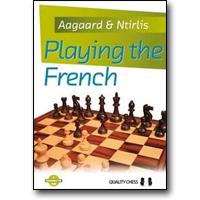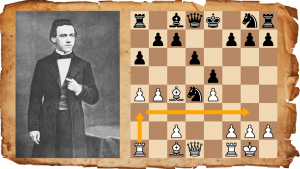
Review: Playing the French
Playing the French is the second opening repertoire book by the Quality Chess authors Jacob Aagaard and Nikolaos Ntirlis. I was very enthusiastic about their first book, The Tarrasch Defence (2011), not because I am a great fan of this opening myself, but because Aagaard and Ntirlis presented an original yet consistent and convincing framework which, despite its complex details, was straightforward and centered around just a few strategic concepts.
Their latest book is an even more ambitious project and, being an occasional French player myself, my expectations were high-strung. The authors claim to present “a fighting repertoire with a minimum of drawish positions and perpetual checks.” They have certainly achieved this goal, but the result is such an abundance and, at the same time, absence of details that it's hard to imagine any Black player adopting this repertoire without going (or being) slightly mad.
First, let me deal with a couple of sidelines. At club level (and, in fact, well above that), these are never to be underestimated, as I know from experience, but Aagaard and Ntirlis deal with them rather briefly. For instance, after 1.e4 e6 2.Nc3 d5, they write that “It is practical to meet 3.Nf3 with 3...Nf6, and after 4.e5 Nfd7 5.d4 we reach variation B of Chapter 12. Harald Keilback in his original work Knight on the Left: 1.Nc3 agrees with me.”
This may be true, but there's a little bit more to it, for White's extra option 5...c5 6.Bg5!? (which is the introduction to the dangerous 'Jackall Variation') is nowhere mentioned.
Just too easy
Curiously, against the gambit line 1.e4 e6 2.Nf3 d5 3.e5 c5 4.b4!? the authors' recommended continuation is 4...cxb4 which, at the very least, gives White exactly what he wants. Their main line continues with 5.a3 bxa3 6.d4 Nc6 7.c3 Bd7 8.Bd3 h6 9.0-0 a6 10.Nxa3 Rc8
“This position has been recommended by Eingorn and his assessment is that White has insufficient compensation for the pawn. My engines don't believe him, but I certainly do after looking at this position for a long time and playing it against both humans and my PC. As in many other lines in the French Defense, we can afford to leave our king on his original square in order to take care of more urgent matters first. In this case White has long-term prospects on the queenside, as our kingside can take care of itself without help. A set-up that I found very comfortable for Black here was ...Na5, ...Rc6 and ...Qc7 followed by ...Nge7 or even ...Bxa3 followed by ...Nge7, ...Nc4 and ...b5; I couldn't find a way for White to stop this or make it ineffective.
11.c4 In the only practical test, White tried this move, but it fails to trouble Black. However, a calmer build-up by White would allow Black to follow the plan mentioned above. For example: 11.Qe2 Na5 12.Bb2 Ne7 13.Nc2 Nf5 Black is developing easily, and let's forget his extra pawn.”
That does sound convincing, doesn't it? They've looked it ‘for a long time’ and even played the position out against humans and a computer! But if this is such a good position for Black - who has a pawn extra - why do all engines keep evaluating this position as roughly equal if not minimally better for White? The authors don't bother answering this question but it's a very relevant one indeed. After all, this is a gambit so all White seeks is compensation for the pawn - and according to the strongest engines in the world, he has it!
I'm not claiming I understand this position better than Eingorn, Aagaard and Ntirlis, who are all much stronger than me, but in my opinion it's just too easy to say you don't believe your engines and then only give one sample line to illustrate your point, especially if your audience doesn't all consist of fellow title holders.
What if White just develops his pieces and just sits on his space advantage until Black runs out of useful moves? Even the weird-looking 11.Qb3!?!, which is Rybka's suggestion - actually provoking Black's plan of Na5 and Rc6 - is not clear at all: White retains long term chances on both wings and Black must wait passively even if he can carry out his dream plan until White shows his cards.
This is what (positional) gambit play is all about, after all. If that kind of long-term compensation isn't worth taking a bit more seriously, then we might as well dismiss the entire Volga/Benko Gambit. I, for one, would be happy to play this position with White against equal opposition if given the chance, especially knowing that Houdini and Rybka are supportive in principle.
Building a repertoire
The authors use similar reasoning in the Euwe System of the Advance Variation. In this notoriously tricky gambit in which White sacrifices all his central pawns, the recommended line is 1.e4 e6 2.d4 d5 3.e5 c5 4.c3 Nc6 5.Nf3 Bd7 6.Bd3 cxd4 7.cxd4 Qb6 8.0-0 Nxd4 9.Nbd2! Ne7 10.Nxd4 Qxd4 11.Nf3 Qb6 12.Be3 Qd8!
Aagaard and Ntirlis mention that this important position has been analysed at length by many other authors in the recent past, such as Viktor Moskalenko, Nikita Vitiugov and Simon Williams. Black's last move was dismissed by Antic & Maksimovic in The Modern French (2012) but Aagaard and Ntirlis “couldn't find anything wrong with this move.” Indeed, their analysis convincingly show that Black doesn't have much to fear if he does his homework: “13. Ng5 (...) gives White compensation, not an advantage. The situation is highly unclear, but not at all bad for Black.”
Based on the concrete evidence presented in Playing the French, this seems certainly true. But here, too, it's obvious that White players who have this system in their repertoire are perfectly happy to play this position knowing they have ‘mere’ compensation. Why give them what they want and walk into their preparation? Black still has to memorize lots of tricky variations with lots of opportunities to go astray along the way.
Aagaard and Ntirlis often seem strangely blind to this element of practical play, preferring to focus on whether Black can survive from a theoretical and computer-analyzed perspective - instead of pausing to ask the question whether Black actually wants to play these positions in the first place. (To their credit, the authors also analyze the alternative option 9...Nxf3+ instead of 9...Ne7, but this, they admit, leads to a position “where White's chances could be evaluated as a tiny bit better.”)
Sharpest possible version
Here's another example of what I mean, in a fascinating line of the the MacCutheon variation with the rare 6.Bc1: 1.e4 e6 2.d4 d5 3.Nc3 Nf6 4.Bg5 Bb4 5.e5 h6 6.Bc1 Ne4 7.Qg4 g6 8.a3 Bxc3+ 9.bxc3 Nxc3 10.Bd3!
10...b6! 11.a4 Qd7 12.Ra3 Nxa4 13.c4! Bb7 14.Bc2!?N Bc6 15.cxd5 Qxd5 16.Bxa4 b5! 17.Bd1 Qxg2 18.Qxg2 Bxg2 19.Bf3 Bxh1 20.Bxh1 c6
“We have reached an unclear endgame with White having two strong bishops against a rook and three pawns. I would evaluate the position as objectively somewhat better for Black, although White has his trumps as well.”
This evaluation may well be entirely correct, but the question is also whether you would want to play this position without analyzing it extensively yourself first and knowing exactly where to put your pieces? Why don't the authors explain what's going on and give some basic ideas for both players to support their verdict? Isn't this what chess students are mostly interested in?
This is my problem with much of the material presented in Playing the French: it’s all highly original, but very often it's also very concrete, highly untested, sharp as a razor's edge and therefore dangerous if you don't study it yourself very well. Stuff like this is not only ‘unfinished business’, but also risky business. One fresh grandmaster game in this line could demolish an entire branch of your repertoire - without much of a backup.
In general I would only recommend this book to extremely serious, confident and dedicated students who are not afraid to spend a lot of time familiarizing themselves in great detail with the variations presented in this book. The content of Playing the French is often much too theoretical to be of much value to the practical player, but at other times it's nowhere near detailed enough to serve as a truly ‘scientific’ guide to the French.
Take another important line treated in the book: the Tarrasch Variation (3.Nd2). The authors’ main choice against this is again the sharpest possible version of 3…c5:
1.e4 e6 2.d4 d5 3.Nd2 c5 4.exd5 Qxd5 5.Ngf3 cxd4 6.Bc4 Qd6 7.0-0 Nf6 8.Nb3 Nc6 9.Nbxd4 Nxd4 10.Nxd4 a6 11.Re1 Qc7 12.Bb3 Bd6
“13.Nf5 This is the main idea behind playing 11.Re1, and to someone seeing this position for the first time, it looks really dangerous. However, there is enough practical material nowadays to ascertain that Black can equalize. (…)
13…Bxh2+ 14.Kh1 0-0 15.Nxg7 Rd8! 16.Qf3 Kxg7
We can now see the point of the zwischenzug with the rook. It is not immediately obvious how White should continue his attack. From this point on, both sides have to proceed with caution, as a single inaccurate move can lead directly to disaster. The following notes may seem daunting to some readers, as it seems that Black has to remember a lot of complicated theory, but if you play through the notes a few times at home, you should not find it difficult to repeat the moves at the board.”
Seriously? I’ve looked at this line myself a couple of years ago, and the (theoretical) complexities in this position are vast - there’s no way you can understand what’s going on by just ‘playing through the notes a few times at home’. For starters, the only move given for White in this position is 17.Bh6+! which is indeed the strongest continuation, but what if White plays something like 17.Qe3!?
I recall looking at this move at the time, and my question to Aagaard and Ntirlis would be how many people they think are able to find the only defense 17…Kh8! 18.Qg5 Nd7! 19.Qh4 Bd6! behind the board? Even there, the situation is actually far from clear without an engine running in the background for constant help.
And this is just one pretty random line in this variation, not even White's most promising option (which, according to the authors, is 12.Qe2! and also leads to hellishly complex play).
If I were Black, I think I would prefer the slightly inferior endgames after 4...exd5 against the Tarrasch Variation - because the other stuff is just way above my head without spending hours and hours analyzing it myself. (Ironically, the book’s back cover assures us that “the characteristic blocked pawn centre leads to situations where a player with superior understanding can overcome an opponent whose expertise lies in computer-assisted preparation”!)
Examples like this make the book strangely unsatisfying to me, the authors’ trademark originality and audacity notwithstanding. Despite the sometimes really good, well-analyzed content, too often I found myself doubting if the authors knew anything at all about practical tournament chess. For all their frequently repeated assertions that this is "a practical guide", they don't seem to believe it themselves.
Unfinished symphony
This Christmas, Lars von Trier’s much-anticipated new and controversial movie Nymphomaniac will hit the cinemas – or rather, a trimmed-down version of it, for the original 5,5 hour movie was cut to 4 hours and split in two parts which will be released separately a few weeks later. Von Trier has already declared that this cut-down version is incoherent and that he refuses to take responsibility for it. And he is right, of course.
I couldn’t help thinking of Lars von Trier (who, by the way, has an equally original and creative ambition as Aagaard and Ntirlis do) when I read Jacob Aagaard’s Introduction to Playing the French. There, he writes that the book’s first draft was close to 700 pages – that is, 250 more than the present publication – “as we had checked virtually every possibility in every line, but eventually managed to whittle the project down to the present version.”
In my view, it would have been better to stick to the original and include those additional 250 pages after all - or perhaps to split the book into two equal volumes. I think it would have made a much more coherent piece of work and I would probably not have had the feeling that I was listening to an unfinished symphony. Now, like in Lars von Trier’s case, the work feels incomplete and therefore doesn't live up to its potential.
Author's note: the original text of the review (which was lost during writing) also contained a positive paragraph on the book's treatment of the Chigorin variation (2.Qe2) which should have been included as well.



